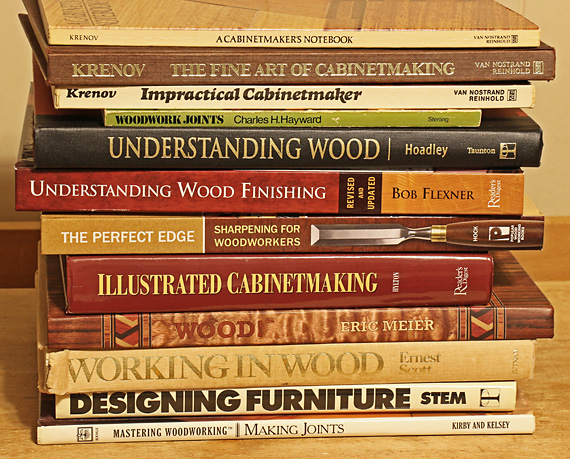
Disclaimer: Or what they do tell you but you might not notice.
I offer for your consideration the following four points regarding learning woodworking:
1. No matter the amount of instruction you receive or the sources you consult, you ultimately have to get into your shop, and with your brain and hands, find your personal approach to building things with wood. This is not to say you should wing it, nor adopt a sophomoric attitude toward competent instruction, but you must find the way to deliver yourself – your talent, ambition, and, yes, courage – through your fingertips to the work on the bench.
2. Learning is continuous. Yes, you reach a point where the general principles of woodworking come together in mind and hand, and from there it is easier to add new skills. But new frontiers are always out there, and will always be humbling and challenging. For me, some examples are use of non-wood materials, art skills such as carving and marquetry, bent lamination panels, along with many more.
3. The corollary of the second point is to beware of being bedazzled by any so-called expert who you might think has seen it all and knows it all, and so can be relied upon for all definitive answers. Sure, there are some great woodworking teachers out there, but none that should supplant your common sense. We all have more to learn.
4. I’ve made this point before but it bears repeating. The most difficult part of making a piece is the big picture – putting all of the elements together. This is true, I suppose, of any field of endeavor.
The design must create enthusiasm. The wood, joinery, and construction plan must make sense to carry out the design. Each of the construction elements – stock preparation, joints, finishing, etc. – must be coordinated and carried out with cognizance of their roles along with particular attention to the critical junctures. Furthermore, you must be willing and able to make adjustments and corrections along the way based on continuous assessment of the work.
The only way to get good at this, which is what really makes you a “good woodworker,” is to build things!
One more post in this series is coming.


Happy New Year RP,
I am going to pester you about your shooting board, as a LEARNER :) seriously though, I really appreciate the blog. I check frequently for new posts, so I don’t miss anything new.
When it comes to the shooting board post “My Shooting Board’ from December 2019, you use 2 lag screws to secure the subfence to the main fence. In the post you noted the lags are in “slots” so they can be adjusted laterally. Why would it need to be adjusted laterally? When too much of the subfence has been planed away?
With regard to the lag screws and the tape or paper for shimming. You mount the main block to the board, with the lag holes present. Then drive the lags through the main fence into the subfence, and adjust from there? Does the subfence not just get pulled into the main fence and contort into the main fences shape – hopefully it is square
Thanks,
Rick
Hi Rick,
Yes, the slots for the lag screws allow for lateral adjustment of the poplar subfence. This not only allows for wear of the subfence but also allows for a precise initial setup. You can shift the subfence to just the right spot and then tighten the bolts.
The lags are in clearance holes (the slots) in the fence block. They are not driven through. (The threads do not engage.)
The subfence does not really contort when the lags are tightened because it has some stiffness of its own. Judicious placement of the shim(s) (and these, if any, are very thin, say .002″ or .004″) also helps avoid any tendency of the subfence to bow. And, a trace of concavity along the length of the subfence is not a bad thing. Convexity is bad because the workpiece can rock, leading to inconsistent results.
Consider too that you don’t always want to shoot dead square. Often you are building in a tiny bit of intentional out-of-squareness, especially in cabinet work. This is another reason for adjustability in the fence. This is homegrown microadjustability.
I hope this helps!
Thanks for reading.
Rob
Thank you Rob, yes that is helpful. I love the usage of shims throughout the shop. From building the “microadjustability” into the underside of the E2 router table, to here with the subfence. I was looking at quite a few boards with the lag screws instead being bolts that were put into the main fence top down, that would then allow for adjustment of angles – the same way you’re doing with the shims in yours. I like your solution, so I will start there and see where we land!
Thanks again.
Great, Rick. Yea, built-in fine adjustment capability is better than the all-in/going for broke methods commonly recommended.
Good luck with it. A shooting board will be one of the most useful tools in your shop.
Rob